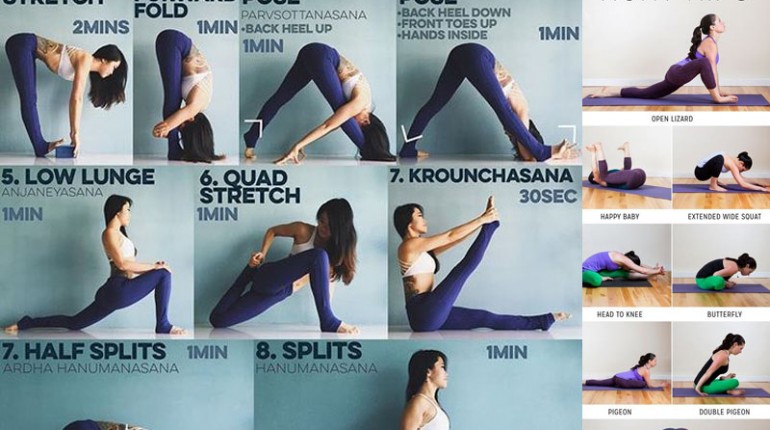
How Can Stretching Help Improve Flexibility: Unlocking the Secrets of Suppleness
Flexibility, the ability of muscles and joints to move through their full range of motion, is a key component of overall physical fitness and health. Achieving and maintaining flexibility is essential for injury prevention, enhancing athletic performance, and promoting better posture. One of the most effective ways to enhance flexibility is through regular stretching exercises. In this comprehensive article, we will explore the science behind flexibility, the benefits of stretching, different types of stretches, and how you can incorporate them into your daily routine to unlock a more supple and mobile body.
Understanding Flexibility
Flexibility is determined by various factors, including muscle length, joint structure, and the elasticity of connective tissues such as tendons and ligaments. It’s important to note that genetics can play a role in an individual’s baseline level of flexibility. However, even if you are naturally less flexible, regular stretching can significantly improve your range of motion and overall flexibility.
Benefits of Improved Flexibility
Before delving into the mechanics of how stretching enhances flexibility, let’s explore why it’s so important:
1. Injury Prevention
Improved flexibility reduces the risk of muscle strains, ligament sprains, and joint injuries. When muscles and joints move through their full range of motion, they are less likely to become strained or injured during physical activities.
2. Enhanced Athletic Performance
Athletes in various sports, from gymnastics to basketball, benefit from increased flexibility. Greater range of motion can translate to improved agility, balance, and coordination, leading to enhanced athletic performance.
3. Better Posture
Flexible muscles and joints contribute to better posture. When your body is more limber, it’s easier to maintain correct alignment, reducing the risk of developing musculoskeletal problems associated with poor posture.
4. Pain Relief
For individuals suffering from chronic pain conditions like lower back pain or arthritis, targeted stretching can provide relief by reducing muscle tension and improving joint mobility.
5. Stress Reduction
Stretching exercises often incorporate deep breathing and relaxation techniques. This combination helps reduce stress and promotes a sense of calm and well-being.
How Stretching Enhances Flexibility
Stretching works by gently elongating muscles and connective tissues, which can become shortened or tight due to inactivity, repetitive movements, or aging. When you stretch, several physiological changes occur:
1. Muscle Fiber Lengthening
Stretching helps increase the length of muscle fibers. Over time, regular stretching can lead to muscle elongation, allowing for a greater range of motion.
2. Improved Blood Flow
Stretching increases blood flow to the stretched muscles. This enhanced circulation delivers nutrients and oxygen, promoting muscle health and recovery.
3. Enhanced Joint Mobility
Stretching also benefits joint health by promoting the lubrication of joint surfaces and enhancing their range of motion.
4. Relaxation of Muscles
Stretching triggers the relaxation response in muscles, reducing muscle tension and promoting a sense of relaxation and well-being.
Types of Stretches
There are various stretching techniques, each targeting specific muscle groups and tissues. Here are some common types of stretches:
1. Static Stretching
Static stretching involves holding a stretch in a stationary position for a set duration. It’s excellent for improving overall flexibility and is typically performed after a workout.
2. Dynamic Stretching
Dynamic stretching involves controlled, repetitive movements that take a joint or muscle through its full range of motion. It’s ideal for warming up before exercise.
3. Proprioceptive Neuromuscular Facilitation (PNF)
PNF stretching is a more advanced technique that involves a combination of stretching and contraction. It’s often done with a partner and is particularly effective for improving flexibility.
4. Yoga and Pilates
Yoga and Pilates are mind-body practices that incorporate various stretching exercises to improve flexibility, balance, and strength.
Incorporating Stretching into Your Routine
To reap the benefits of improved flexibility, it’s essential to incorporate stretching into your daily routine. Here’s how to get started:
1. Warm Up First
Always warm up before stretching. A few minutes of light aerobic exercise, such as jogging in place or jumping jacks, will increase blood flow and prepare your muscles for stretching.
2. Stretch Consistently
Consistency is key to seeing improvements in flexibility. Aim to stretch regularly, ideally at least 2-3 times a week or after each workout.
3. Focus on Major Muscle Groups
Pay attention to major muscle groups like hamstrings, quadriceps, calves, hip flexors, and the upper body. Targeting these areas can have a significant impact on overall flexibility.
4. Hold Stretches
When performing static stretches, hold each stretch for 15-30 seconds, gradually increasing the duration as your flexibility improves.
5. Breathe and Relax
During stretching, remember to breathe deeply and relax into the stretch. Avoid bouncing or forcing your body into a position; instead, gently ease into each stretch.
6. Listen to Your Body
Stretching should never cause pain. If you feel pain, back off the stretch slightly. Stretch to the point of tension, not discomfort.
Conclusion
Flexibility is a fundamental aspect of overall health and physical fitness, and stretching is a powerful tool to help you achieve and maintain it. Regular stretching not only reduces the risk of injury but also enhances athletic performance, promotes better posture, and contributes to a sense of well-being. By understanding the science of flexibility and incorporating various stretching techniques into your routine, you can unlock the secrets of suppleness and enjoy a more agile, mobile, and pain-free body. So, start stretching today and embrace the benefits of a more flexible you!



